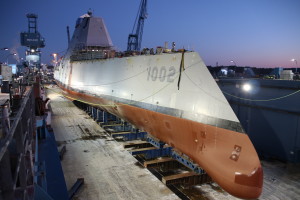General Dynamics’ Bath Iron Works [GD] (BIW) president Dirk Lesko announced layoffs and production staying below typical operations due to the continued strike by Local S6 of the Machinists Union.
In a July 7 message to employees, Lesko said since the strike began, BIW has taken steps to continue critical production tasks like redeploying hundreds of salaried employees into the shipyard while working with contractors to procure more workers during the strike.
Zumwalt-class destroyer Lyndon B. Johnson (DDG-1002) was launched at the General Dynamics-Bath Iron Works shipyard in Bath, Maine on Dec. 9, 2018. (Photo: General Dynamics-Bath Iron Works)
“However, all of these efforts still leave our production levels well below typical operations and even further below where we need to be. As a result, some functions that directly support production are beginning to run out of work to do,” Lesko said.
While the company explored options to reassign impacted employees to other jobs, since they are not available BIW this week is starting temporary layoffs for Surveyors and Trades Inspectors affected, with members in the separate Local S7 union. Layoffs will proceed in accordance with the Local S7’s collective bargaining agreement with the company.
The Local S6 union voted to go on strike on June 21, starting the walkout of June 22. It is the first strike by the union in decades. The Local S6 represents 4,300 of BIW’s 6,700 employees (Defense Daily, June 22).
The strike went forward after the union rejected the company’s new three-year contract bid. Opposition is largely focused on seniority privileges; increases to employee healthcare contribution, copays and deductibles; and whether the company should change how it hires subcontractors for shipyard work.
At the time the company said they were prepared for the strike. The last BIW strike lasted for 55 days.
In June, Assistant Secretary of the Navy for Research, Development and Acquisition James Geurts told reporters the Navy expects BIW and the union to “work very diligently and with a sense of urgency to come to agreement so that we can get our ship construction – keep it on track.”
The layoff process is starting by offering voluntary layoffs, but if that is not sufficient the company will begin involuntary layoffs based on seniority.
“While these layoffs are temporary in nature, their impact on employees and their families is real and immediate. At a time when we are behind schedule, it is frustrating to be sending our employees home. However, the disruption of the strike leaves no other option,” Lesko said.
He argued the company has hired over 2,000 employees since 2018 and needs to hire at least another 1,000 this year while they invest in the supply chain to increase throughput.
In a previous July 2 message, Lesko said before the strike company staffing was 500 people below what was needed due to attrition and the COVID-19 pandemic.
In that message he disclosed BIW was starting to work with contractors to get more temporary workers to supplement the ones already there to support the shipyard during the strike.
Lesko argued in its negotiations with the union BIW has sought more efficient access to subcontractors “because the focused and timely introduction of skilled people on a temporary basis can help break bottlenecks to the flow of production through the yard.”
